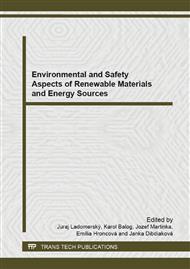[1]
V. Babrauskas and R.D. Peacock: Heat release rate: the single most important variable in fire hazard. Fire Saf. J. Vol. 18 (1992), pp.255-272.
DOI: 10.1016/0379-7112(92)90019-9
Google Scholar
[2]
J. Martinka, T. Chrebet, I. Hrušovský, K. Balog and S. Hirle: Fire risk assessment of spruce pellets. Appl. Mech. Mater. Vol. 501-504 (2014), pp.2451-2454.
DOI: 10.4028/www.scientific.net/amm.501-504.2451
Google Scholar
[3]
Q. Xu, A. Majlingová, M. Zachar, C. Jin and Y. Jiang: Correlation analysis of cone calorimetry test data assessment of the procedure with tests of different polymers. J. Therm. Anal. Calorim. Vol. 110 (2012) pp.65-70.
DOI: 10.1007/s10973-011-2059-7
Google Scholar
[4]
Q. Xu, M. Zachar, A. Majlingová, C. Jin and Y. Jiang: Evaluation of plywood fire behaviour by ISO tests. European Journal of Environmental and Safety Sciences. Vol. 1 (2013) pp.1-7.
Google Scholar
[5]
A. Osvald: Fire protection (Technical University of Zvolen, Slovakia 2005).
Google Scholar
[6]
ISO 871: 2006: Plastics: determination of ignition temperature using a hot-air furnace.
Google Scholar
[7]
L. Shi and MIL. Chew: Experimental study of woods under external heat flux by autoignition, J. Therm. Anal. Calorim. Vol. 111 (2013) pp.1399-1407.
DOI: 10.1007/s10973-012-2489-x
Google Scholar
[8]
M.A. Delichatsios, TH. Panagiotou and F. Kiley: The use of time to ignition data for characterizing the thermal inertia and the minimum (critical) heat flux for ignition or pyrolysis. Combust. Flame. Vol. 84 (1991) pp.323-332.
DOI: 10.1016/0010-2180(91)90009-z
Google Scholar
[9]
V. Mózer: On equivalent fire exposure. European Journal of Environmental and Safety Sciences. Vol. 1 (2013) pp.18-23.
Google Scholar
[10]
V. Mózer, A. Osvald, T. Loveček, A. Fanfarová and Ľ. Vráblová: Fire safety in tunnels forming part of critical infrastructure, in: 47th IEEE International Carnahan Conference on Security Technology (Medelin, Colombia 2013).
DOI: 10.1109/ccst.2013.6922042
Google Scholar
[11]
P. Kučera, A. Lokaj and V. Vlček: Behavior of the spruce wood and birch wood from fire safety point of view. Adv. Mater. Res. Vol. 842 (2014) pp.725-728.
DOI: 10.4028/www.scientific.net/amr.842.725
Google Scholar
[12]
P. Kučera, A. Lokaj and D. Kačíková: Assessment of reliability of timber structures elements exposed large-scale fire test. Acta Facultatis Xylologiae. Vol. 54 (2012) pp.95-104.
Google Scholar
[13]
J. Ladomerský and E. Hroncová: Investigation of wood waste combustion efficiency in burning chamber on basis of emission. Acta. Mech. Slovaca. Vol. 7 (2003) pp.595-600.
Google Scholar
[14]
J. Ladomerský, E. Hroncová and D. Samešová: Investigation of appropriate conditions for wood wastes combustion on basis of emission. Drew. Vol. 46 (2003) pp.90-98.
Google Scholar
[15]
J. Martinka, D. Kačíková, E. Hroncová and J. Ladomerský: Experimental determination of the effect of temperature and oxygen concentration on the production of birch wood main fire emissions. J. Therm. Anal. Calorim. Vol. 110 (2012) pp.193-198.
DOI: 10.1007/s10973-012-2261-2
Google Scholar
[16]
N.N. Semenov: Thermal ignition, in: Some problems of chemical kinetics and reactivity, edited by N. N Semenov, volume 2, chapter 1, Pergamon (1959).
Google Scholar
[17]
T. Chrebet: Investigation of thermal decomposition ignition of pure and impregnated lignocellulosic materials (AlumniPress, Slovakia 2012).
Google Scholar
[18]
J. Mahút and M. Královič: Selected woods of southeast Asia and its fire characteristics, in: Wood & Fire Safety: 6th international conference, edited by A. Osvald (Technical University in Zvolen, Slovakia 2008).
Google Scholar
[19]
A. Osvald and L. Osvaldová: Retardation of spruce wood burning (Technical University in Zvolen, Slovakia 2003).
Google Scholar
[20]
D. Kačíková, M. Netopilová and A. Osvlad: Wood and its thermal decomposition. (SPBI, Czech Republic 2006).
Google Scholar
[21]
E. Orémusová: Influence of the retardation substances applied by various technological procedures on beech veneers combustion heat. in: Fire engineering: the 1st international conference, edited by I. Marková (Sabovci Bothers, Slovakia 2002).
Google Scholar
[22]
H. Qu, W. Wu, H. Wu, Y. Jiao and J. Xu: Thermal degradation and fire performance of wood treated with various inorganic salts. Fire Mater. Vol. 35 (2011), pp.569-576.
DOI: 10.1002/fam.1075
Google Scholar
[23]
A.M. Pereyra and C.A. Giudice: Flame-retardant impregnants for woods based on alkaline silicates. Fire Saf. J. Vol. 44 (2009), pp.497-503.
DOI: 10.1016/j.firesaf.2008.10.004
Google Scholar
[24]
E. Ružinská: The study of thermal characteristics of modified products isolated from kraft black liquor for formulation of new type of adhesive mixtures. Wood Res. Vol. 48 (2003) pp.22-35.
Google Scholar
[25]
I. Tureková and K. Balog: Flame ignition parameters of polyethylene and activation energy of initiation of combustion process. Res. Pap. Vol. 11 (2001), pp.181-186.
Google Scholar


